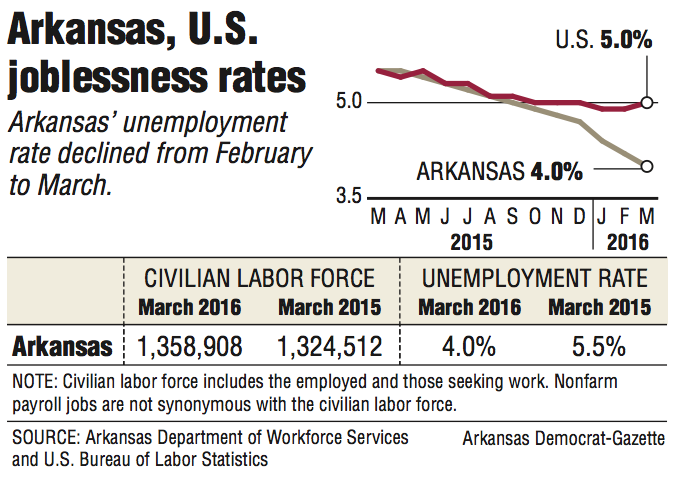The unemployment rate in Arkansas dropped to 4 percent in March, its lowest level in 59 years, the U.S. Bureau of Labor Statistics said Friday.
The state's unemployment rate was 4.2 percent in February.
The national rate was 5 percent in March.
Arkansas' unemployment rate has not been as low as 4 percent since 1957, as far back as data are available, according to the bureau.
From 1957 to 1975, unemployment data were published in annual reports to the president, which included only annual unemployment rates, a spokesman with the bureau said. From 1976 to the present, it has reported monthly rates for each state.
Before March, the lowest recorded rate in Arkansas was a 4.1 percent annual unemployment rate in 1969.
"The labor force is growing, employment is growing, the number of unemployed is down so low," said Kathy Deck, director of the Center for Business and Economic Research at the University of Arkansas at Fayetteville. "This looks fantastic all the way around."
In March, the labor force was the highest since February 2012. There were more Arkansans employed in March than any time since June 2008. And the number of unemployed in Arkansas in March was the lowest since November 2000.
Arkansas is experiencing a 2.2 percent rate of employment growth, which is above the U.S. level, said James Howard, an economist with the bureau's office in Dallas.
The state is outperforming neighbors' unemployment rates -- Missouri at 4.2 percent, Texas at 4.3 percent, Oklahoma at 4.4 percent, Tennessee at 4.5 percent, Louisiana at 6.1 percent and Mississippi at 6.3 percent.
"That's not necessarily the normal report for Arkansas," Deck said. "The reason is that our metropolitan areas and even our nonmetropolitan areas are seeing job growth right now."
Northwest Arkansas is "clicking on all cylinders," Deck said.
"That's been true even when Arkansas was down," Deck said. "But what really has made the difference is that central Arkansas, which as a region traditionally has slow growth, is performing very well right now. Because it's the largest area in the state, when it does well it's not surprising to see the state overall doing well."
The Fort Smith metropolitan area also had positive growth compared with March last year, Deck said.
The unemployment rate has dropped seven-tenths of a percentage point in only three months, which is unprecedented, said Michael Pakko, chief economist at the Institute for Economic Advancement at the University of Arkansas at Little Rock.
Arkansas' unemployment rate has dropped for the past 11 months, beginning with a decline from 5.5 percent in April last year to 5.4 percent last May.
"Everything is moving in the right direction," Pakko said. "For several months, the unemployment rate has been coming down. Employment is consistently increasing."
Pakko suggested that the low unemployment rates in Arkansas could be revised up somewhat next March when the Bureau of Labor Statistics does its annual revision.
"How substantial the revisions [will be is hard to estimate]," Pakko said. "But at this point I wouldn't be surprised if the decline in the unemployment rate that we've seen in the last three months will turn out to be smaller, more muted."
The record low unemployment rate is causing businesses across the state problems in filling jobs.
Kenneth Calhoun, a vice president at Truck Centers of Arkansas, has 20 openings for diesel mechanics at Truck Centers' offices in North Little Rock, Springdale and Van Buren.
Qualified workers could begin at more than $35,000 a year.
Even though Truck Centers has classes to train applicants, the company can't fill the classes, Calhoun said. The last class the company started had only three students, half of the six that the class could hold, Calhoun said.
"We always have openings," Calhoun said.
The University of Arkansas for Medical Sciences, which has employees in 73 of Arkansas' 75 counties, can't fill its openings, said Leslie Taylor, a spokesman for the hospital.
It has more than 100 nursing vacancies, 18 in lab pathology and 14 for radiology technologists. It also has openings for housekeeping jobs and even for police officers, Taylor said.
"We also have physician positions we're trying to fill," Taylor said. "Part of that is those positions are very competitive, and Arkansas doesn't pay as much as other states, such as the University of Mississippi Medical Center, which gets much more state funding."
Arkansas' unemployment rate is the 16th-lowest in the country, tied with Virginia at 4 percent.
An unemployment rate of 4 percent was considered to be full employment when he graduated from college in the early 1980s, said Greg Kaza, an economist and executive director of the Arkansas Policy Foundation in Little Rock. But the current definition is considered to be closer to 5 percent, according to the Congressional Budget Office.
Full employment is the state of the economy in which all eligible people who want to work can find employment at prevailing wage rates.
South Dakota had the lowest unemployment rate in the country in March at 2.5 percent, followed by New Hampshire at 2.6 percent, Colorado at 2.9 percent, Montana at 3 percent and North Dakota and Hawaii at 3.1 percent each.
Alaska had the highest unemployment rate last month at 6.6 percent, followed by Illinois and West Virginia at 6.5 percent each, Mississippi at 6.3 percent and Alabama and New Mexico at 6.2 percent each.
A Section on 04/16/2016
